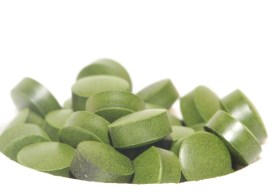In this months edition we shift gears slightly to focus on a “super-food” most commonly found in the form of a dietary supplement; Spirulina.
Spirulina is a cyanobacteria; meaning that it’s a bacterium which derives its energy through photosynthesis. Cyanobacteria are also commonly known as blue-green algae. Spirulina is commonly made from two strains of cyanobacteria: Arthrospira platensis and Arthrospira maxima. Although now cultivated around the world, spirulina is found naturally growing in only three lakes: Lake Chenghai (China), Lake Chad (Africa) and Lake Texcoco (Mexico).
Spirulina is available at most health food stores in the form of powder, flake or tablet. Much like Quinoa, Spirulina is a complete protein source, containing all essential amino acids. It is also a source of essential fatty acids and is one of the only vegan friendly reservoirs of the omega-3 fatty acids EPA and DHA. Spirullina’s blue-green pigment is an indicator that it is rich in vitamins and other beneficial anti-oxidants. These antioxidants include, but are not limited to: beta-carotene, zeaxanthin, and chlorophyll. The unique blend of antioxidants found in spirulina make it a fascinating health promoting supplement, which has demonstrated benefit in the treatment of HIV, brain health, heavy metal chelation, cardiovascular disease and allergies.
The Journal of Nutritional Science and Vitaminolgy published a paper that investigated the effect of supplementing rats prone to the development of cognitive disease , similar to Alzheimer’s disease, with spirulina. Alzheimer’s disease is characterized by the deposition of amyloid beta-protein, which is thought to “gum up” the functioning of neurons in the brain. The rats studied were bred to be prone to the deposition of amyloid beta-protein. One group of rats received daily supplementation of 50mg/kg spirulina, another group received 200mg/kg spirulina and the third group did not receive spirulina. Analysis of the rat brains (poor rats) demonstrated a reduction in amyloid beta-protein in both spirulina treated groups. There were also lower levels of oxidative damage in the brains of spirulina treated rats. Therefore spirulina may be a beneficial supplement for the prevention of Alzheimer’s disease in genetically prone individuals.
Back in 1998 a paper was published that investigated the effect of spirulina extract on the growth of HIV in human white blood cells. It was found that extract concentrations ranging between 0.3-1.2 micrograms/ml reduced the growth of HIV by 50%. The authors concluded that spirulina may be a potential agent used for the treatment of retroviruses like HIV.
Aside from a runny nose, itchy eyes and sneezing, seasonal allergies are characterized by a relative increase in white blood cells known as TH2 cells. One of the ways TH2 cells increase and cause allergy is by a messenger molecule in the blood called interleukin 4 (IL4). In 2005 the Journal of medicinal food published a study that looked at the blood of individuals with allergic rhinitis before and after supplementing with spirulina. The study was a placebo controlled randomized crossover trial where individuals either received 1g, 2g spirulina or placebo daily for 12 weeks. The blood samples at 12 weeks found that 2g spirulina per day reduced IL4 levels by 32%.
Environmental medicine is an exciting emerging field of medicine that looks at how toxins in our environment effect our health, and more importantly how to protect ourselves from the harmful effects of environmental toxins. There are few natural substances that have demonstrated an ability to promote the excretion of some of these harmful toxins, spirulina is one of them. A study published in 2006 looked at the effect of a spirulina and zinc supplement on individuals in Bangladesh chronically exposed to the toxic metal arsenic. These individuals were given 250mg spirulina extract and 2mg zinc twice daily for 16 weeks. There was a increase in urinary excretion of arsenic (detoxification) at 4 weeks which continued for an additional 2 weeks in individuals taking the spirulina zinc combo. At 16 weeks the spirulina plus zinc combo removed 47.1% arsenic from scalp hair (one of the ways to test for arsenic exposure is through hair analysis), whereas results from placebo were not statistically significant. Other studies have shown that spirulina may also chelate (remove) iron, which can be useful for individuals with toxic amounts of iron in the body but may be counter productive for individuals taking an iron supplement.
It seems that a large part of the health benefits seen through the use of spirulina are due to its unique blend of antioxidants. A laboratory study discovered that cells exposed to harmful chemicals had 4-5 times less apoptosis (cell death) when treated with an aqueous extract of spirulina. Another study demonstrated that a diet supplemented with 0.1% spirulina protects against inflammation and oxidative damage in brain neuronal cells. This same studied showed that spirulina increased the proliferation of neural stem cells which have the ability to replace damaged cells. Spirulina is therefore a promising natural supplement for the field of neural and cognitive health.
A study published in the november 2007 edition of the journal: Lipids in Health and Disease, investigated the effect of spirulina supplementation on cholesterol and blood pressure. Thirty six men and women had blood cholesterol levels and blood pressure measured before the study. They were supplied with 4.5g/day spirulina for 6 weeks. There were no other changes to diet and exercise. After 6 weeks total cholesterol levels decreased by approximately 20 mg/dl, tracylglycerides decreased by approximately 60 mg/dl and HDL (good cholesterol) increased by approximately 10 mg/dl. Systolic and diastolic blood pressure also decreased in participants by approximately 10 mmHg. With all the health promoting benefits of spirulina, it is important to consider a few things before taking this medication. As with every supplement, allergy can occur so be careful to monitor and possible allergic symptoms when taking spirulina for the first time. Spirulina contains the amino acid phenylalanine, which can be harmful for individuals who cannot metabolize this amino acid known as phenylketonuria. Since spirulina is a water born blue-green algae it is important that it is not sourced from a contaminated water source. I would recommend going with a reputable supplement company. Spirulina is a very promising natural dietary supplement whose beneficial effects can be seen in almost every organ system in the body. These effects are likely due to its unique blend of antioxidants. Use this supplement with necessary caution and remember that in nature there exist both beneficial bacteria and harmful bacteria, a naturopathic doctor can help to explain the difference and point you in the right direction toward optimal health.
Title: Reduction in symptoms associated with Fibromyalgia at six weeks using Intravenous Vitamins and Minerals (Myers Cocktail).
Running Header: Myers Cocktail for Fibromyalgia
Author: Dr. Shawn Meirovici N.D.
Physio-Logic 96 Scarsedale Road, Toronto, Ontario, M3B 2R7
Disclaimer: Patient consent was obtained
Key words: Intravenous, Vitamins, Minerals, Fibromyalgia
Abstract: Fibromyalgia is a musculoskeletal disorder characterized by widespread pain commonly with one or more coexisting symptoms. Treatment often includes both non-pharmacological and pharmacological therapy. Pharmacological therapy includes the use of antidepressants and GABA derivatives with varying success rates and often with unpleasant side effects. Micronutrient infusion is a newer approach with the majority of use in the field of alternative medicine. To date one placebo controlled pilot study has examined its use in fibromyalgia patients noting statistically significant effects on pain and fatigue. The following is a case study using a similar “cocktail” as the one used in the placebo controlled trial, for 4 treatments using the modified visual analogue scale of the fibromyalgia impact questionnaire (mVASFIQ) as an endpoint measure. Significant reduction in all parameters of the mVASFIQ was noted at 6 weeks, suggesting that micronutrient infusion should be further investigated as a treatment approach for fibromyalgia.
Background: I have a special interest in the treatment of chronic pain. Operating out of a rehabilitation clinic in Toronto, Canada has allowed me the opportunity to work with neurological conditions and traumatic injuries of which chronic pain is often a prevalent symptom. Fibromyalgia is characterized by chronic widespread pain and often involves disruption of many body systems including the gastrointestinal tract. While pharmaceutical intervention is focused on regulating the body’s response to pain, many alternative therapies are focused on restoring function to debilitated body systems. One such treatment is the Myers Cocktail: a intravenous micronutrient therapy that delivers vitamins and minerals directly into the blood stream thereby bypassing the gastrointestinal tract. There is both a review and placebo controlled pilot study demonstrating intravenous micronutrient therapy as an effective treatment for symptom reduction in fibromyalgia. [1] [2]
Introduction: Fibromyalgia is characterized by chronic widespread pain, increased tenderness at specific sites known as “tender points,” un-refreshing sleep, fatigue and cognitive dysfunction not attributable to other disease states. While the etiology of fibromyalgia is not entirely clear, associations with trauma, adverse life events, impaired mood, anxiety, irritable bowel syndrome, cold intolerance, paresthesias and other medical conditions have been described. The pharmacologic treatment of fibromyalgia ranges from antidepressants to analgesics. Here we are commenting on a novel treatment involving the infusion of vitamins and minerals also known as a Myers Cocktail.
Case Presentation: J.M. is a 38-year old female who had been diagnosed with fibromyalgia in 2008. Her symptoms started approximately 10 years ago after enduring a series of traumatic life events. Symptoms included: chronic widespread pain, non-restorative sleep, muscle weakness, morning stiffness, subjective swelling, multiple chemical sensitivities, frequent severe headaches, vestibular dysfunction, TMJ, paresthesia, chronic fatigue, dysmenorrhea, anxiety and irritable bowel syndrome. J.M. had tried a number of GABA derivatives, antidepressants and analgesics with varying degrees of relief but with significant adverse reactions including aphasia, depression and dyspepsia. At initial presentation, J.M. was taking Wellbutrin 300mg XL daily and Tylenol with Codeine as needed. She felt that she was starting to develop a tolerance to Wellbutrin. She was not taking any dietary supplements and was not on any type of specialized diet or exercise program.
J.M. was prescribed an intravenous infusion Myers Cocktail (B-complex 1ml, Dexpanthenol 250mg, Pyridoxine 100mg, Hydroxocobalamin 1mg, Ascorbic Acid 2000mg, Calcium Chlroide 100mg, Magnesium Chloride 1000mg and Sterile Water 46ml) via 60cc syringe with a 24 Gauge butterfly needle at the right median cubital vein, delivered over 15 minutes once per week for 4 infusion sessions. This patient completed a modified visual analogue scale of the fibromyalgia impact questionnaire (mVASFIQ) at initial consult (Image 1) and again after her final infusion (Image 2). She was also prescribed magnesium malate 1.5 grams per day, 1000iu vitamin D per day and 1mg melatonin at night 30 minutes before sleep. However, J.M. was admittedly not taking these supplements consistently during the 4 weeks of intravenous treatment.
The mVASFIQ score at treatment initiation was: (Fatigue 9.5, Insomnia 9.5, Depression 4.5, Anxiety 6.5, Rigidity 8.5, Pain 8.5, Difficulty with work 8.5) at four weeks the mVASFIQ score was: (Fatigue 3, Insomnia 5, Depression 1, Anxiety 3, Rigidity 3, Pain 3, Difficulty with work 3). Besides mild nausea and flushing during the first treatment no adverse effects were reported.
Discussion: Micronutrient infusion delivers vitamins and minerals involved in stress response, muscle contraction and nerve signaling, while able to bypass the need for gastrointestinal absorption. This is an effective delivery method for chronic conditions, such as fibromyalgia, where there is often gastrointestinal disruption as well as the potential for micronutrient deficiencies. The results of this case study demonstrate that micronutrient infusion Myers Cocktail may be an effective treatment for fibromyalgia related symptoms as indicated by a decreased in symptoms score on mVASFIQ at 6 weeks post treatment. This joins the small collection of evidence for the validity of this treatment for fibromyalgia. More study into this treatment for fibromyalgia is warranted.
Confounding Factors: As was outlined in the treatment plan, J.M. received a few dietary supplements on initial consult; however, J.M. admitted to not taking these consistently throughout the 4 intravenous treatments. The patient received all 4 infusions by myself and was not blinded to the treatment. There was also no placebo control. Additionally, the patient may have been influenced by the doctor patient relationship or through placebo effect. However the significant improvement observed within a relatively short time helps to validate the results of this study.
[1] Intravenous Micronutrient Therapy (Myers’ Cocktail) for Fibromyalgia: A Placebo-Controlled Pilot Study, Ather et al., The Journal of Alternative and Complementary Medicine, Volume 15, Number 3, 2009, pp. 247-257
[2] Myers’ Cocktail, Dr. Alan Gaby M.D., Alternative Medicine Review, Volume 7, Number 5, 2002.
Image 1
mVASFIQ for J.M. on July 18th 2015 (patient incorrectly marked X in box rather than a check through the appropriate line, therefore, results have +/- 0.5 confidence interval.
Image 2
mVASFIQ for J.M August 28th 2015.







